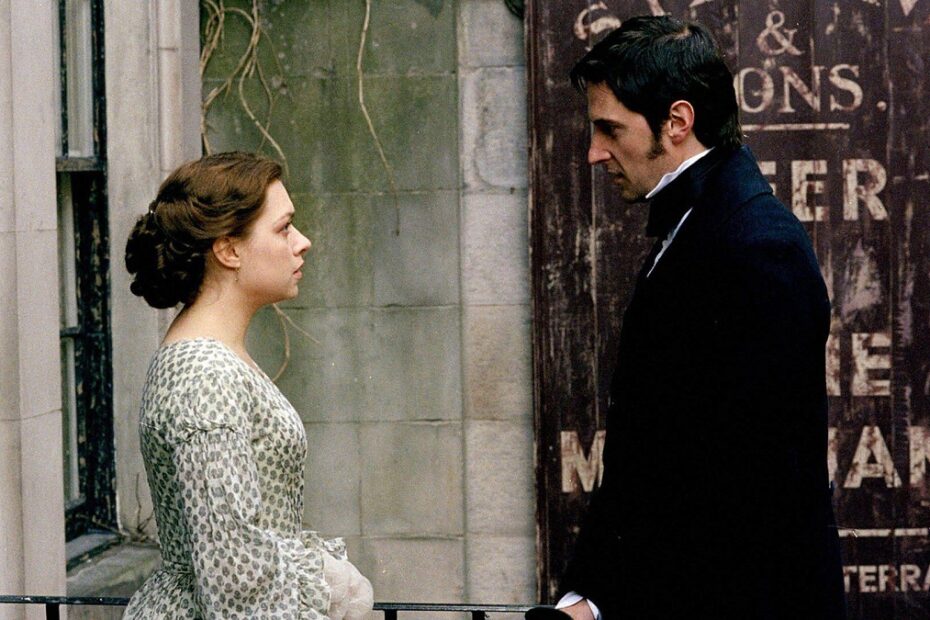North and South by Elizabeth Gaskell was published in 1855 amid the Industrial Revolution in the Victorian Era. Classed as an Industrial Novel, it is regarded as one of the finest novels for the examination of what transpired in that period in England, from politics to culture. The novel tells the story of the southern Margaret Hale. She is forced to deal with new conditions of life by moving to Milton, where she meets the Northerner John Thornton. Margaret soon starts to develop a new perspective on life and to comprehend those in the industrial city.
Right at the first meeting of the protagonist couple, we have access to Thornton’s fascination for Margaret’s hands and arms. During a conversation between Mr. Hale and Mr. Thornton, Margaret has her attention focused on serving cups of tea, a representation of domesticity brought on by Gaskell. Mr. Thornton’s eyes are focused on Margaret’s hands, reporting them as thin and delicate, resembling the domesticity and idealism of the time, where housewives should have fine and delicate characteristics, such as: “prettiness, silence, and daintiness”. Margaret’s hands are objectified, as tools to be used, in this case as much as John admired them, it was Mr. Hale who put his daughter’s hands to use. This becomes clear when we see Margaret sacrificing herself to meet everyone’s requests throughout the book. She tries to be helpful, ignoring conversations most of the time, and focusing her attention on serving tea.
Gaskell presents a contradictory scenario, juxtaposing Margaret who is neglecting a conversation as she is busy with domestic duties, and John who is neglecting the conversation precisely because he is paying attention to Margaret’s movements, arms and hands. Mr. Thornton narrates the movements of Margaret’s bracelet, where he tries to control his fetishistic fixation on her bracelet as it “tightened her soft flesh” (Page 74, Chapter X), taking on a sexual connotation.
Despite these links between hands and issues of utility, control, and desire, the novel further brings the body to the fore. This can be seen in the passage in which Margaret tells John to speak to the working class. In contrast to the scenes of hands and touches in Thornton’s idealized domestic spaces, the book shifts Thornton’s perspective to the protesting audience. Margaret becomes the focus of the scene as she tries to resolve the situation by being helpful and like in the tea scene, she uses her arms and body to try to appease the conflict. Gaskell’s narrator also conveys the touch and even Margaret’s fall with a charge of eroticism, which we can see, for example, in Thornton’s reaction every time Margaret touches him or deflects his touch. From the beginning, Margaret’s view of the female body is that, as a woman, she has a power of persuasion that can be sustained in the domestic space. Proof of this is given in the strike when Margaret tries to protect John. The crisis is not averted, however, as the strikers not only took it too far, but Margaret also misunderstood the driving force of the class struggle taking place. In a violent impulse, the crowd violates the female body through violence, something symbolic, seen as immaculate. Right after this, Gaskell places the female body as a vessel of sexualization. There, it is possible to see Thornton’s reaction as charged with eroticism by Margaret’s touch on his neck.
Elizabeth Gaskell explores Margaret’s hands as a means for the character to express herself. Her hands become indicators of frustration and then are used as shields to hide her nervousness. Gaskell later builds a parallel to Margaret’s clenched hands when Thornton recalls Miss Hale’s mysterious encounter at the train station: “the remembrance shot through him like an agony, till it made him clench his hands tight in order to subdue the pain” (Page 249, Chapter XXXIII).
The author uses the word “hands” to emphasize anything from romantic interest to social realism. Thornton refers to his workers not as men but as “hands”, reducing an entire group of people to a part of their bodies. This linguistic supremacy reflects physical and social supremacy, and Thornton acknowledges this on page 112, Chapter XV: ”Miss Hale, I know, does not like to hear men called “hands”, so I won’t use that word, though it comes most readily to my lips as the technical term, whose origin, whatever it was, dates before my time”. While Margaret wants to be seen as a purposeful person, she does not think the same of the strikers and disapproves of this overly utilitarian vocabulary, in which workers are portrayed as mere bodies made for labor rather than human beings. Mr. Thornton later in the book tells Nicholas that he should leave his brain at home. The terminology is used to suggest that workers and their hands are like industrial tools as if they were separate from the rest of the body.
Later, toward the end of the book, we see John talking to Mr. Bell about creating a dining room for his employees and once again he uses the word “hands” to refer to his employees: “I’m building a dining-room—for the men I mean—the hands” (Page 334, Chapter XLII). His perceptions have evolved, and he now partially perceives his employees as men. It is evident how significantly Margaret contributed to this shift in perspective by encouraging Thornton to humanize his employees. Margaret ultimately plays a crucial part in John’s “education,” guiding him to view others the way he would like to be seen: as a man. Margaret seeks to change not only Thornton’s vocabulary for the ‘hands’ but also change the way he thinks, listens, and acts.
In addition to using the “bodily” element in the novel’s political plot to focus on individual issues, Gaskell also uses a focus on the hands to emphasize Thornton’s difference from other models of gentlemanliness. For example, the author presents Margaret’s two marriage proposals from two completely different men. In the case of the Southern “gentleman” Henry Lennox, his physical possession and strength are received as a firm, bodily, silent rejection: “’Margaret,’ said he, taking her by surprise and getting sudden possession of her hand, so that she was forced to stand still and listen[…]” (Page 27, Chapter III). In contrast, we have Mr. Thornton. His first proposal emphasizes the passion and impulse to hold and not own Margaret’s hand: “He held her hand tight in his hand. He panted as he listened for what should come.” (Page 181, Chapter XXIV). While with Lennox, Margaret only reacts to his actions, with Thornton she acts as well, showing that John respects and opens up so the woman can also express and react. While Thornton is judged for his behavior at work, Lennox is never challenged for his actions. Lennox’s feelings are superficial and masked, his actions can be read as a sign of gentlemanly control, while Thornton reacts more earnestly to the rejection. Not only does Lennox fail to show respect for women, thinking of how he also disdains Edith, but he also sought to win Margaret over the social ladder.
Elizabeth Gaskell establishes a pattern of removable men: Margaret’s father for example at the beginning of the novel seems like a perfect Southern gentleman and throughout the book, Gaskell uses him to represent a profoundly emotional gentlemanly manner of treating social inferiors as equals. Still, he fails a lot as a father and husband, allowing his feelings and needs to dominate him. Mr. Hale frequently be taken care of by his daughter, making her assume responsibilities that were not hers. He embodies the traditional classical education of a gentleman which is initially imbued with greatest value in the novel. On his turn, Mr. Bell is unique in the sense that Gaskell’s remaining emblem of ‘traditional’ gentlemanliness prevails without further interrogation. By the end of the novel, however, he dies and is removed from the text, not remaining in the future of Milton.
At the end of the story, a denouement is added for each supposed gentleman: Mr. Lennox has not fulfilled his appointment, Frederick is thriving while living in exile in Spain and Mr. Hale and Mr. Bell are dead. The narrative then focuses on Mr. Thornton. The penultimate sentence at the end of the novel: “That man!” (Page 403, Chapter LII) shifts narrative emphasis from a Southern gentleman to a Northern man. Just as Thornton’s earlier conversation with Margaret underscores the importance of the man over the gentleman, the novel ends with an emphasis on the man, both linguistically and narratively, with Gaskell continually banishing these models of traditional gentlemen from the novel’s conclusion.
References:
GASKELL, Elizabeth. North and South. Hertfordshire: Wordsworth Editions, 1994.
LOWE, Meghan. Masculinity in the Work of Elizabeth Gaskell. Springer Nature, 2020.
Publicado por
Graduanda em Letras Inglês/Literaturas na Universidade do Estado do Rio de Janeiro. Curadora de conteúdo no projeto de extensão Literatura Inglesa Brasil. Amante de Literatura Afro-Americana e Cultura Pop. Suas pesquisas estão entre os dois mundos. Pesquisadora de Zora Neale Hurston, buscando uma leitura mulherista em sua narrativa. E, recentemente, pesquisadora de canções narrativas presentes no álbum Harry's House (2022) de Harry Styles.


Karen, I loved your analysis! What I find beautiful about Margaret and Thornton is that they have really changed each other for the better and that is certainly a quality for a happy couple.